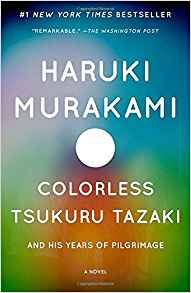The Colorless Tsukuru Tazaki and his Years of Pilgrimage
Haruki Murakami
 Tsukuru Tazaki is an engineer in Tokyo who is living his dream: building railway stations. Recently he started to see Sara, a travel agent, and as they get closer, Tsukuru opens up and tells her a secret: 16 years ago, when he was a student in Tokyo, the tight-knit group of friends he belonged to in highschool abruptly and without explanation cut off all ties to him. Sara urges him to find closure, and he agrees to visit his four friends in Nagoya and get to the bottom of the issue. Tsukuru returns to his old world of friendship, dominated by unwritten obligations to protect the weakest member under all circumstances…
Tsukuru Tazaki is an engineer in Tokyo who is living his dream: building railway stations. Recently he started to see Sara, a travel agent, and as they get closer, Tsukuru opens up and tells her a secret: 16 years ago, when he was a student in Tokyo, the tight-knit group of friends he belonged to in highschool abruptly and without explanation cut off all ties to him. Sara urges him to find closure, and he agrees to visit his four friends in Nagoya and get to the bottom of the issue. Tsukuru returns to his old world of friendship, dominated by unwritten obligations to protect the weakest member under all circumstances…
The novel’s title is an allusion to the names of the five friends: All except Tsukuru’s last name contain a color: red, blue, white, black. Haruki Murakami draws an image of deep friendship among the five highschool students which is destroyed forever on outcasting one of them, who, for lack of understanding, is himself reduced to utter despair that lasts for years.
When I first read this novel, I found it incomprehensible how the four “color” people could ditch Tsukuru from one day to the other without explanation, without talking to him, without apparent remorse. Now that I lived in Japan for longer, I can see that this is a very standard Japanese pattern. It is done to protect the harmony of the group, which is paramount in Japanese society and thinking. And sometimes, it’s not the “guilty” person who has to leave, it is somebody else. Been there, had that done to me…
Haruki Murakami is probably the best known contemporary Japanese author. Born in Kyoto in 1949, he studied drama in Tokyo and became the owner of a Jazz bar. At age 29, he started writing, and since has become one of the most acclaimed writers world-wide. Even though many Japanese critics don’t like his work because they see it as “too Western”, he has won many prizes in Japan as well as abroad.
Interesting book – check it out on amazon.
